Remove the connecting rod caps (A).
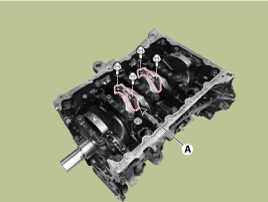
Mark the connecting rod caps for reassembly in the original position and direction.
Use fender covers to avoid damaging painted surfaces.
To avoid damaging the cylinder head, wait until the engine coolant temperature drops below normal temperature (20°C [68°F]) before removing it.
When handling a metal gasket, be careful not to fold the gasket or damage the contacting surface of the gasket.
To avoid damage, unplug the wiring connectors carefully while holding the connector portion.
Mark all wiring and hoses to avoid misconnection.
Turn the crankshaft damper pulley so that the piston of No. 1 cylinder is at TDC (top dead center) on compression stroke.
Remove the engine and transaxle assembly.
(Refer to Engine And Transaxle Assembly - "Engine And Transaxle Assembly")
Remove the transaxle assembly from the engine assembly.
(Refer to Manual Transaxle System - "Manual Transaxle")
Remove the flywheel.
(Refer to Cylinder Block - "Flywheel")
Remove the rear oil seal.
(Refer to Cylinder Block - "Rear Oil Seal")
Install the engine to engine stand for disassembly.
Remove the intake manifold.
(Refer to Intake And Exhaust System - "Intake Manifold")
Remove the exhaust manifold.
(Refer to Intake And Exhaust System - "Exhaust Manifold")
Remove the EGR cooler.
(Refer to Intake And Exhaust System - “EGR Cooler”)
Remove the thermostat housing.
(Refer to Cooling System - “Thermostat”)
Remove the water pump and the water return pipe.
(Refer to Cooling System - “Water Pump”)
Remove the timing chain.
(Refer to Timing System - “Timing Chain”)
Remove the cylinder head.
(Refer to Cylinder Head Assembly - "Cylinder Head")
Check the connecting rod side clearance.
Check the connecting rod bearing cap oil clearance.
Remove the connecting rod caps (A).

Mark the connecting rod caps for reassembly in the original position and direction.
Remove the piston and connecting rod assemblies.
Using a ridge reamer, remove all the carbon from the top of the cylinder.
Push the piston, connecting rod assembly and upper bearing through the top of the cylinder block.
Keep the bearings, connecting rod and cap together.
Arrange the piston and connecting rod assemblies in the correct order.
Mark the piston and connecting rod assemblies for reassembly in the original position.
Check for fit between piston and piston pin.
Try to move the piston back and forth on the piston pin. If any movement is felt, replace the piston and pin as a set.
Disassemble the piston rings.
Using a piston ring expander, remove the 2 compression rings (A).
Remove the oil ring and coil spring (B) by hand.
Do not apply excessive force when removing the oil ring from the piston as it may break the oil ring.
Arrange the piston rings in the correct order only.
Disassemble the connecting rod from the piston.
Remove the snap ring (C) from the piston.
Remove the piston pin (D) from piston.
Disassemble the piston (F) and connecting rod (E).

Check the end play between piston and connecting rod.
End play
Standard : 0.05 ~ 0.302 mm (0.0020 ~ 0.0119 in)
If out-of-tolerance, install a new connecting rod.
If still out-of-tolerance, replace the crankshaft.
Check the connecting rod bearing oil clearance.
Check that the match marks on the connecting rod and cap are aligned to ensure correct reassembly.
Remove the 2 connecting rod cap bolts.
Remove the connecting rod cap and lower bearing.
Clean the crankshaft pin journal and bearing.
Place a plastigage across the crankshaft pin journal.
Reinstall the lower bearing and cap, and tighten the nuts.
Tightening torque :
10.7 ~ 14.7 N.m (1.1 ~ 1.5 kgf.m, 8.0 ~ 10.8 lb-ft) + (88 ~ 92°)
Do not turn the crankshaft.
Always use new connecting rod cap bolts.
Connecting rod cap bolts are torque-to-yield bolts designed to be permanently elongated beyond the state of elasticity when torqued, so if the bolts are removed and reused, it may cause the bolts to break or fail to maintain clamping force.
Remove the 2 bolts, connecting rod cap and lower bearing.
Measure the plastigage at its widest point.
Standard oil clearance
0.025 ~ 0.043 mm (0.0010 ~ 0.0017 in)
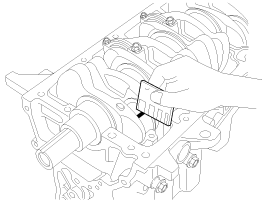
If the plastigage measures too wide or too narrow, remove the upper and lower bearings and then install new bearings of the same color mark.
Recheck the oil clearance.
Do not file, shim, or scrape the bearings or the caps to adjust clearance.
If the plastigage shows the clearance is still incorrect, try the next larger or smaller bearing.
Recheck the oil clearance.
If the proper clearance cannot be obtained by using the appropriate larger or smaller bearings, replace the crankshaft and start over.
If the marks are indecipherable because of an accumulation of dirt and dust, do not scrub them with a wire brush or scraper. Clean them only with solvent or detergent.

Mark | Connecting rod big-end inner diameter |
A | 49.000 ~ 49.006 mm (1.9291 ~ 1.9294 in) |
B | 49.006 ~ 49.012 mm (1.9294 ~ 1.9296 in) |
C | 49.012 ~ 49.018 mm (1.9296 ~ 1.9298 in) |
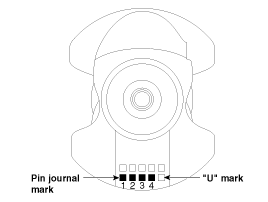
Mark | Crankshaft pin journal outer diameter |
A | 46.009 ~ 46.015 mm (1.8114 ~ 1.8116 in) |
B | 46.003 ~ 46.009 mm (1.8111 ~ 1.8114 in) |
C | 45.997 ~ 46.003 mm (1.8109 ~ 1.8111 in) |
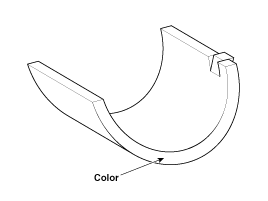
Color | Connecting rod bearing thickness |
Blue | 1.477 ~ 1.480 mm (0.0581 ~ 0.0583 in) |
Black | 1.480 ~ 1.483 mm (0.0583 ~ 0.0584 in) |
None | 1.483 ~ 1.486 mm (0.0584 ~ 0.0585 in) |
Green | 1.486 ~ 1.489 mm (0.0585 ~ 0.0586 in) |
Yellow | 1.489 ~ 1.492 mm (0.0586 ~ 0.0587 in) |
Select the bearing by using selection table.
Connecting rod bearing | Connecting rod mark | |||
A | B | C | ||
Crank shaft pin journal mark | A | Blue | Black | None |
B | Black | None | Green | |
C | None | Green | Yellow | |
Check the connecting rods.
When reinstalling, be sure to install the connecting rod and cap to the correct cylinder number. When installing a new connecting rod, make sure that the notches for holding the bearing in place are on the same side.
Replace the connecting rod if the thrust faces on either end has been damaged. Also, replace the rod if step wear or severely rough surface inside the diameter of the small end is apparent.
Using a connecting rod aligning tool, check the rod for bending and distorsion. If the measured value is close to the repair limit, correct the rod by using a press. Any connecting rod that has been severely bent or distorted should be replaced.
Allowable bendingof connecting rod :
0.05mm / 100 mm (0.0020in / 3.94in ) or less
Allowable distorsion of connecting rod :
0.1mm / 100 mm (0.0039in / 3.94 in) or less
Clean the piston.
Using a gasket scraper, remove the carbon from the piston top.
Using a groove cleaning tool or broken ring, clean the piston ring grooves.
Using solvent and a brush, thoroughly clean the piston.
Do not use a wire brush.
Check the piston-to-cylinder clearance by calculating the difference between the cylinder bore inner diameter and the piston outer diameter.
Piston-to-cylinder clearance :
0.060 ~ 0.080 mm (0.0024 ~ 0.0031 in)
Using a cylinder bore gauge, measure the cylinder bore diameter at position in the thrust and axial direction.
Cylinder bore diameter :
1.4 L : 75.000 ~ 75.030 mm (2.9527 ~ 2.9539 in)
1.6 L : 77.200 ~ 77.230 mm (3.0394 ~ 3.0405 in)

Measure the piston outside diameter at 10 mm (0.39 in) from bottom land of the piston.
Piston outside diameter :
1.4 L : 74.930 ~ 74.960 mm (2.9500 ~ 2.9511 in)
1.6 L : 77.130 ~ 77.160 mm (3.0366 ~ 3.0377 in)
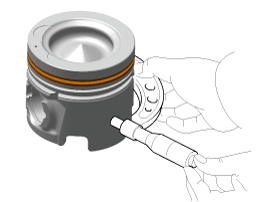
Select the piston matching with cylinder bore class.
Piston-to-cylinder clearance :
0.060 ~ 0.080 mm (0.0024 ~ 0.0031 in)
Check the cylinder bore size code on the cylinder block front face.

Mark | Cylinder bore inner diameter | |
1.4 L | 1.6 L | |
A | 75.000 ~ 75.010mm (2.9527 ~ 2.9531in) | 77.200 ~ 77.210mm (3.0394 ~ 3.0398in) |
B | 75.010 ~ 75.020mm (2.9531 ~ 2.9535in) | 77.210 ~ 77.220mm (3.0398 ~ 3.0402in) |
C | 75.020 ~ 75.030mm (2.9535 ~ 2.9539in) | 77.220 ~ 77.230mm (3.0402 ~ 3.0405in) |
Check the piston size mark (A) on the piston top face.
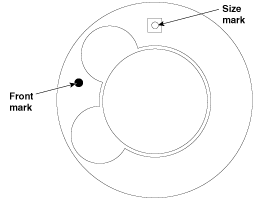
Mark | Piston outer diameter | |
1.4 L | 1.6 L | |
A | 74.930 ~ 74.940mm (2.9500 ~ 2.9503in) | 77.130 ~ 77.140mm (3.0366 ~ 3.0370in) |
B | 74.940 ~ 74.950mm (2.9503 ~ 2.9507in) | 77.140 ~ 77.150mm (3.0370 ~ 3.0374in) |
C | 74.950 ~ 74.960mm (2.9507 ~ 2.9511in) | 77.150 ~ 77.160mm (3.0374 ~ 3.0378in) |
Inspect the piston ring side clearance.
Using a feeler gauge, measure the clearance between new piston ring and the wall of ring groove.
Piston ring side clearance
No.1 : 0.09 ~ 0.13 mm (0.0035 ~ 0.0051 in)
No.2 : 0.08 ~ 0.12 mm (0.0031 ~ 0.0047 in)
Oil ring : 0.03 ~ 0.07 mm (0.0012 ~ 0.0028 in)
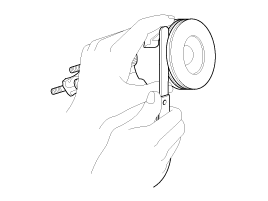
If the clearance is greater than maximum, replace the piston.
Inspect the piston ring end gap.
To measure the piston ring end gap, insert a piston ring into the cylinder bore. Position the ring at right angles to the cylinder wall by gently pressing it down with a piston. Measure the gap with a feeler gauge. If the gap exceeds the service limit, replace the piston rings. If the gap is too large, recheck the cylinder bore inner diameter. If the bore is over the service limit, the cylinder block must be replaced.
Piston ring end gap
No.1 : 0.20 ~ 0.30 mm (0.0079 ~ 0.0118 in)
No.2 : 0.30 ~ 0.45 mm (0.0118 ~ 0.0177 in)
Oil ring : 0.20 ~ 0.40mm(0.0079 ~ 0.0157 in)
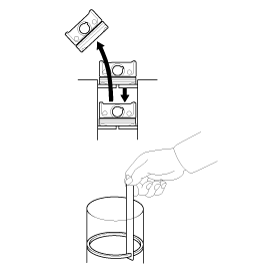
Measure the outer diameter of piston pin.
Piston pin diameter :
27.995 ~ 28.000 mm (1.1022 ~ 1.1024 in)

Measure the piston pin-to-piston clearance.
Piston pin-to-piston clearance :
0.004 ~ 0.015 mm (0.0002 ~ 0.0006 in)
Check the difference between the piston pin outer diameter and the connecting rod small end inner diameter.
Piston pin-to-connecting rod interference :
0.022 ~ 0.039 mm (0.0009 ~ 0.0015 in)
Thoroughly clean all parts to be assembled.
Before installing the parts, apply fresh engine oil to all sliding and rotating surfaces.
Assemble the piston and connecting rod.
Install the snap ring on one side of the piston pin hole.
Align the piston front mark and the connecting rod front mark.
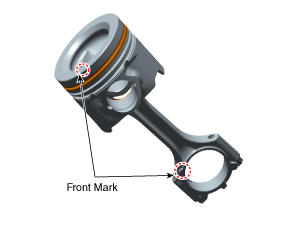
Insert the piston pin into the piston pin hole and the small end bore of connecting rod.
Install the snap ring on the other side after inserting the piston pin.
Apply a sufficient amount of engine oil to outer surface of the piston, inner surface of piston pin hole and small end bore of the connecting rod before inserting the piston pin.
Be careful not to damage and scratch the small end bore, piston pin hole and piston pin when inserting the piston pin.
Set the snap ring firmly so that the snap ring contacts the entire groove of the piston pin hole.
Install the piston rings.
Install the oil ring expander and 2 side rails by hand.
Using a piston ring expander, install the 2 compression rings with the code mark facing upward.
Position the piston rings so that the ring ends are as shown.
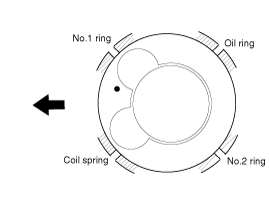
Install the connecting rod bearings.
Align the bearing claw with the groove of the connecting rod or connecting rod cap.
Install the bearing (A) in the connecting rod and connecting rod cap (B).
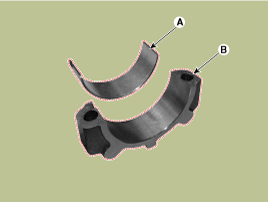
Install the piston and connecting rod assemblies.
Before installing the piston, apply a coat of engine oil to the ring grooves and cylinder bores.
Install the piston and connecting rod assembly with the front marks facing the front of the engine.

Remove the connecting rod caps, and slip short sections of rubber hose over the threaded ends of the connecting rod bolts.
Install the ring compressor, check that the rings are securely in place, then position the piston in the cylinder, and tap it in using the wooden handle of a hammer.

Maintain downward force on the ring compressor to prevent the rings from expanding before entering the cylinder bore.
Stop after the ring compressor pops free, and check the connecting rod-to-crank journal alignment before pushing the piston into place.
Apply engine oil to the bolt threads. Install the rod caps (A) with bearings, and tighten the bolts using the SST (09221-4A000).
Tightening torque :
10.7 ~ 14.7 N.m (1.1 ~ 1.5 kgf.m, 8.0 ~ 10.8 lb-ft) + (88 ~ 92 °)

Always use new connecting rod cap bolts. Connecting rod cap bolts are torque-to-yield bolts designed to be permanently elongated beyond the state of elasticity when torqued, so if the bolts are removed and reused, it may cause the bolts to break or fail to maintain clamping force.
Check the side clearance between piston and connecting rod.
Assemble the remaining parts in the reverse order of disassembly.